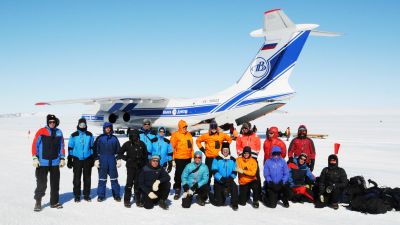
Princess Elisabeth Antarctica Abuzz with Activity
After an extended quarantine in Cape Town, due to poor weather conditions in Antarctica, the 2020-2021 Belgian Antarctic Research Expedition (BELARE) was finally able to reach the Princess Elisabeth Antarctica (PEA) station!
A hectic journey
With the weather having improved in Antarctica, the BELARE team, including Expedition Leader Alain Hubert and several scientists, travelled from Cape Town to the Russian Novolazarevskaya Station (Novo) on Thursday 26 November. Once they had arrived at Novo, the first part of the team was immediately transported to PEA on a Basler to open the station.
Before landing at the airstrip close to the station, the pilot needed a few fly by approaches to assess conditions. The visibility was marginal and the snow cover quite thick. They were taken aback by the incredible amount of snow that had accumulated around the station since last season's team left PEA nine months ago. This would mean a lot of work ahead clearing away snow!
While the first part of the team settled in at the station, mother nature created complications for the rest of the team. During the Basler’s return flight from PEA to Novo, the weather deteriorated. A second flight to PEA the same day would be impossible.
The last four members of the team, along with a lot of scientific equipment, cargo and food for the season, remained stranded at Novo for the next 42 hours while they waited for weather conditions to improve. Thankfully, on Saturday 28 November, the weather was clear enough for the rest of the team and cargo to fly to PEA and be reunited with their BELARE colleagues.
Starting up and settling in
The first order of business for the team was to ensure that all station systems and scientific instruments - which had been running autonomously since the station was closed down at the end of February - were running smoothly. The team then started to collect and melt snow to produce drinking water.
Meanwhile, others used Prinoth tractors to clear massive piles of snow that had accumulated outside the station during the winter. Until A six-metre layer of snow has been cleared away from the station’s annexes doors of the garages and the lower entrance hall. Before that, the team was only able to enter the station through the main red door at the base of the station’s tower.
The team also had to spend several days clearing a flat 120 x 120 metre area in front of the station where they could arrange containers of equipment, mechanical parts, scientific equipment, vehicles and expedition materials.
After four days of hard work, the station’s power generation, water production and water treatment systems were online and fully functional, and enough snow had been cleared to allow the team to operate freely. This is an important accomplishment that allows this year’s expedition to get off to a good start.
First scientists get to work
Three scientists from Ghent University, the Royal Belgian Institute for Space Aeronomy (BIRA-IASB) and the "Ecole Polytechnique Fédérale de Lausanne" (EPFL) who arrived with the first station team have already been able to start their work for the season. They’ve managed to install the majority of their equipment on the roof of the station and in special scientific equipment shelters located on a rocky outcrop not far from PEA
They’re now preparing to do fieldwork, which is scheduled to start in the coming days.
More to come from the team soon. Stay tuned!
Picture: BELARE 2020-2021 team poses near Novolazarevskaya Station in front of the Ilyushin transport plane that brought them to Antarctica - © International Polar Foundation
